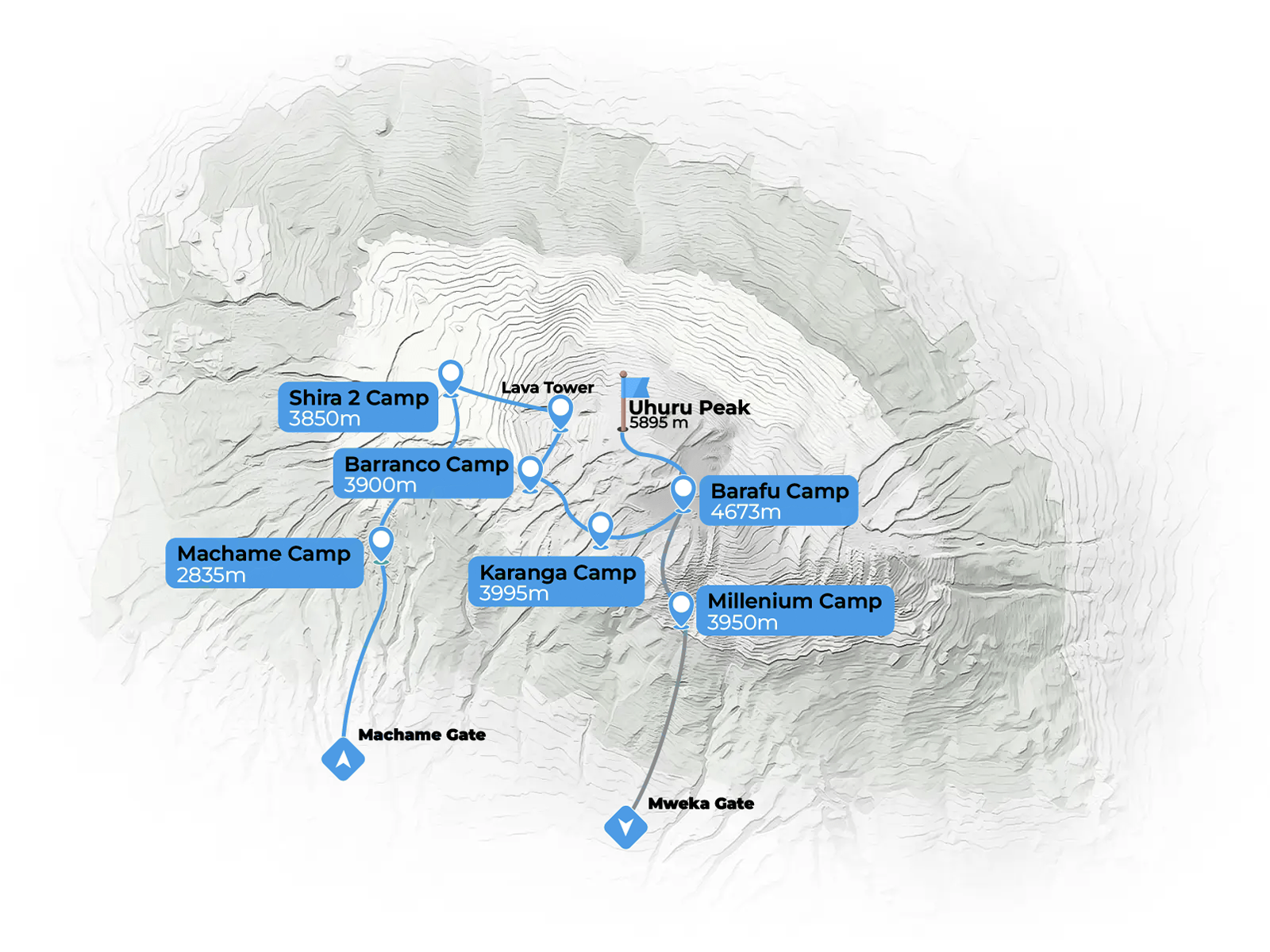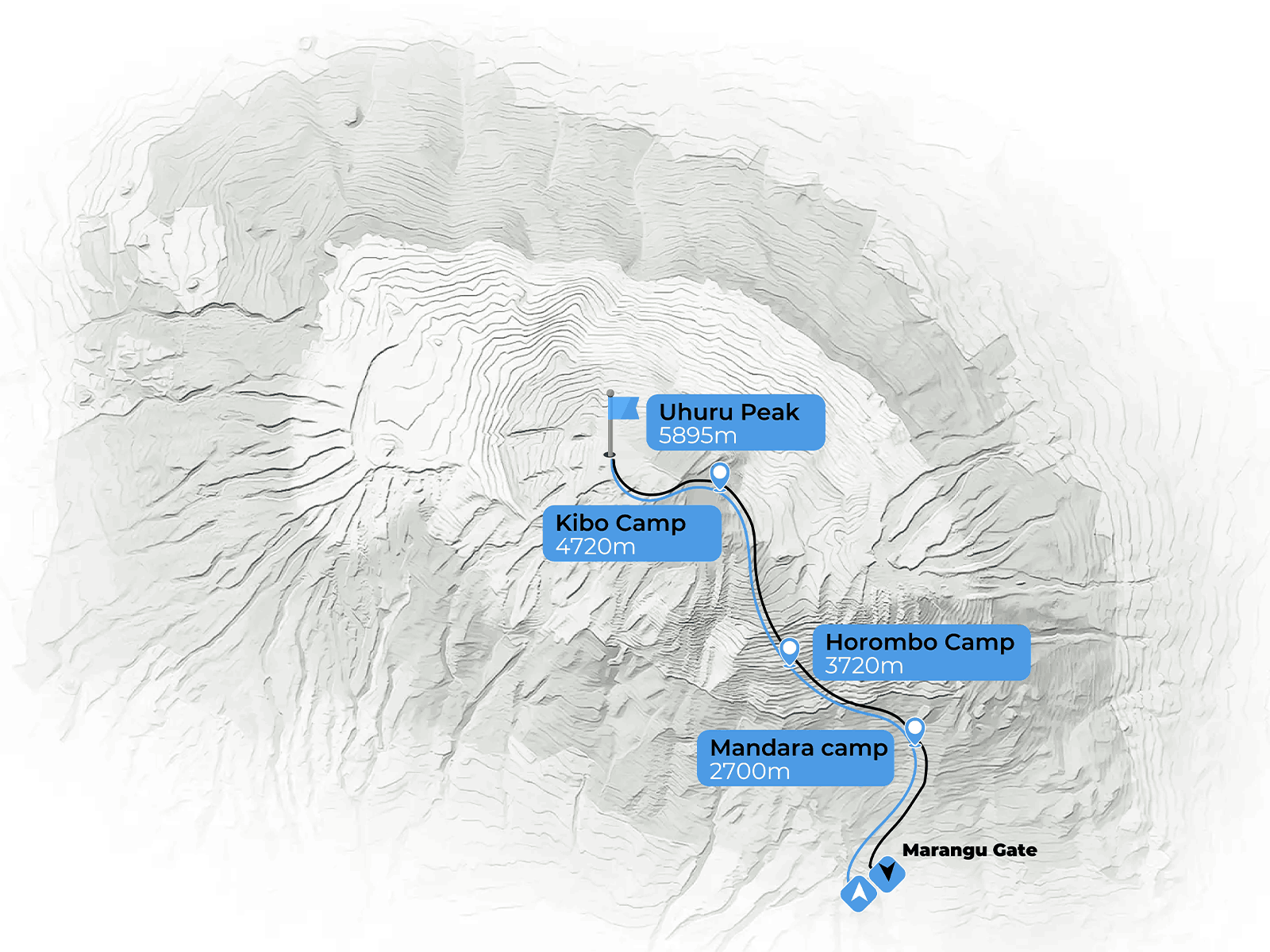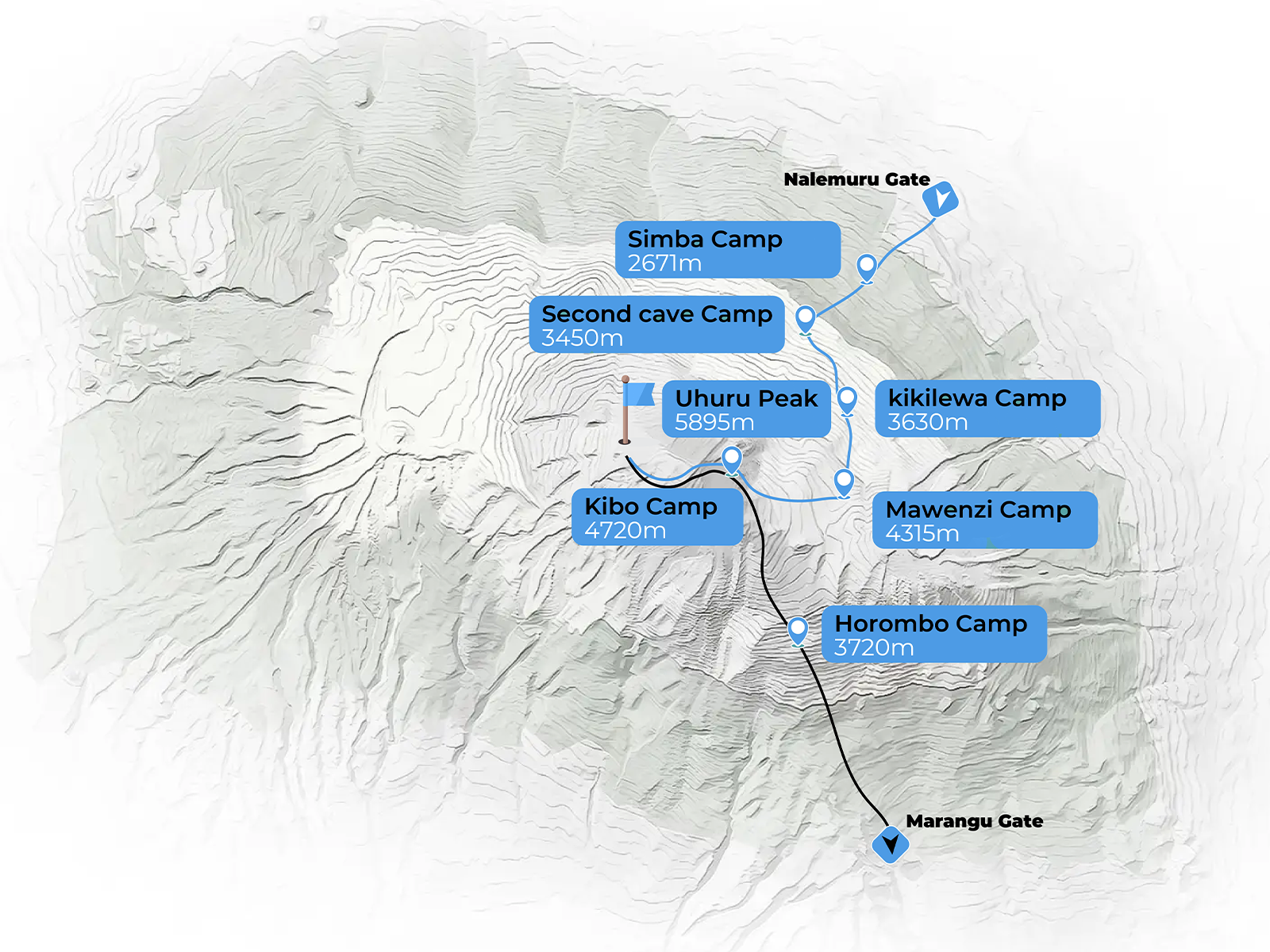Kilimanjaro Hiking Routes
Kilimanjaro Hiking Routes
Before climbing Mount Kilimanjaro, it’s best to know that there are seven well-established routes that you can choose for your trekking adventure. But, which is the best route to scale Mount Kilimanjaro? The answer to this question depends on your experience, fitness, and the views you want to see. If you’re an inexperienced climber, the best route for you is the Marangu route. It’s the easiest route and only takes five days to trek. However, if you’re an adventurous person and want to see the best views in Kilimanjaro, the Machame route will suit you best!
Machame Route
The Kilimanjaro Machame route climbs is our second favourite route on Mount Kilimanjaro. Together with Lemosho, it is widely considered the most scenic with beautiful views and a rich variety of terrain. Therefore, it’s no coincidence that it is a very popular Kilimanjaro route, with the latest figures suggesting that just over 20,000 people climb the Machame route each year. It’s popularity is unfortunately therefore it’s only downfall, in that it can get quite overcrowded in peak season.
The acclimatisation profile of the Machame route is great, making use of the climb high sleep low concept most effectively. The route approaches from south and has a comparatively high success rate, especially for climbers who choose the seven-day option. The six-day Kilimanjaro Machame Route climbs itinerary is not recommended for first-time trekkers as it provides less time for acclimatisation. There are no huts, and only camping is possible on the Machame.
Difficulty: Medium Distance: 62 km Duration: 6-8 days Success rate: High
Lemosho Route
We have to admit, we have a soft spot for the Lemosho route! Because of it’s versatility, scenery and a rather untouched, wild start to the climb, Lemosho is often considered the route with the most variety. Spotting large wildlife, like antelopes is not very common, but possible! One of the really unique things about this route is that it offers trekkers the experience of hiking across the Shira Plateau, one of the largest high-altitude plateaus in the world. The route approaches from the western side of the mountain and is less frequented than other popular Kilimanjaro routes. It’s effectively a variant of the Machame route with only the first two days of the trek differing.
The acclimatisation profile of the Lemosho route is great, with repeated climb high sleep low opportunities throughout leading to high success rates. Most people complete the Lemosho route in seven days, but it can be extended by one day to give yourself a little longer to acclimatise if needed. Camping is the only available option for the Lemosho route.
Difficulty: Medium Distance: 70 km Duration: 7-8 days Success rate: High
Marangu Route
The Marangu route, nicknamed the “Coca-Cola” route, stands as the oldest and most established path on Kilimanjaro. It distinguishes itself by offering sleeping huts with shared dormitory-style accommodations instead of camping. Each of the Mandara and Kibo Huts houses 60 bunk beds, while the Horombo Hut contains 120 bunk beds. Guests are provided with mattresses and pillows, although sleeping bags remain necessary. These huts feature communal dining areas and basic washrooms, ranging from modern amenities like flushing toilets and running water at lower altitudes to simpler facilities such as long-drop toilets and buckets of water at Kibo Hut.
Many prefer the Marangu route due to its reputation as the mountain’s easiest path, characterized by a gradual slope and a direct trajectory. However, its limited duration makes acclimatization to altitude challenging. This route approaches Mount Kilimanjaro from the southeast, yet it lacks the scenic variety of other paths since both ascent and descent follow the same trail. Consequently, it tends to be the most congested route due to this single-track nature.
Difficulty: Low Distance: 72 km Duration: 5-6 days Success rate: Low
Rongai Route
The Kilimanjaro Rongai route trek is basically one long hike with a very gentle gradient and a low difficulty level. It is the only route that approaches from the Northern side of the mountain and is less frequently climbed. Only around 4,000 people climb it each year.
The Kilimanjaro Rongai Route Trek is similar to the Marangu route in terms of its lack of climb high sleep low opportunities. It’s therefore recommended to do the seven-day itinerary rather than the six-day one, giving you an important extra day to adjust to the altitude. It’s generally considered a good alternative to the more crowded routes such as the Marangu, especially for those climbers preferring camping over huts.
The route is less crowded, moderately steep, crosses a beautiful alpine desert zone and allows for good views towards Kenya and the Kibo summit. On this route, you return via the Marangu route.
Difficulty: Low Distance: 73 km Duration: 6-7 days Success rate: Medium
Umbwe Route
The Umbwe route is renowned as the most demanding path on Mount Kilimanjaro, earning its reputation rightfully. Due to its rapid ascent to high altitudes, this trail lacks the gradual stages necessary for proper acclimatization. Despite the trail being scarcely populated, the likelihood of success remains low. Umbwe is acknowledged as an extremely strenuous and challenging route, suitable only for seasoned hikers who are confident in swiftly adjusting to high altitudes.
Approaching from the southern side, the Umbwe route is characterized by its brevity, steepness, and direct ascent. Upon reaching Barranco Camp, the trail veers eastward, passing beneath Kilimanjaro’s Southern Ice Field along the Southern Circuit before reaching the summit via Barafu. The descent follows the Mweka route.
Difficulty: High Distance: 53 km Duration: 5-6 days Success rate: Low
Northern Circuit Route
The Northern Circuit route is one of the best routes on Kilimanjaro, offering nearly 360 degrees of beautiful scenery including the quiet, rarely visited northern slopes. As the longest route on Kilimanjaro, the Northern Circuit also has the most acclimatization time and the highest summit success rate. Thus, the Northern Circuit route is highly recommended.
The route approaches Mount Kilimanjaro from the west, beginning with a long drive from Moshi to Londorossi Gate. From there, the first two days are spent trekking through the rainforest to Shira Ridge, before crossing the Shira Plateau. The route then heads north and circles clockwise from Moir Hut to Buffalo Camp to School Hut, before summiting from the east. Descend is made via the Mweka route.
Difficulty: High Distance: 98 km Duration: 8-10 days Success rate: High












